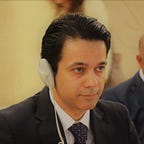The Oil Price War: Trump Emerges Winner
The world has just come out of the petroleum-industry equivalent of the Cuban Missile Crisis, marked by heightened diplomatic suspense and international high-powered backchannel diplomacy. In its aftermath, a surprising and welcome convergence between major powers — to stabilize the oil market — leads to both cautious optimism and fears about calm that precedes a storm.
From the streets of San Antonio in the United States, to Dubai, and to Wuhan in China, late-April and early-May traffic data suggests the oil market is on the way to recovery and demand will gradually rise, and that the worst of the oil demand destruction is behind us. But will it ever get back to the 100 million barrel per day mark? The odds are stacked against a full recovery. Work and life habits are changing. Work-from-home and meetings-over-video-conferencing models have made a strong entry. If these trends hold, or if there is a second or third wave of the virus outbreak, global demand may never return to pre-pandemic levels.
President Trump has succeeded for now in brokering a truce between Saudi Arabia and Russia, bringing major oil producers to agree on unprecedented output cuts. Even India and China contributed by lifting some excess crude from the market in early April, building reserves and helping reduce the glut. America has firmly established its credentials as the world’s leading oil producer, which is a challenge for Russia, KSA and the Gulf states, and a recipe for future tensions.
The oil crisis hits India’s economy hard, but how this will impact Indian military modernization plans and its footprint in Kashmir, home to world’s longest lockdown in modern times, is yet to be seen. Strategically, low demand, with 1.3 billion Indians under stay-home orders, India has reduced its oil intake from KSA, UAE, Iraq, and Kuwait, where it went when US sanctions flattened its import of Iran’s oil.
The recovery is also good news for Iran. Flat oil prices could have hurt the Iranian government more than the stale economy and sanctions. Tehran is surviving thanks to crude sales to China, Syria and in the black market. Initially, Iran sneered when the Russian-Saudi oil war hit American shale oil revenues. But, ironically, it is Trump’s intervention in the global oil market that gives Tehran some relief.
Pakistan did not have the storage capacity or financial liquidity to use the oil price war to build strategic reserves. But the economic slump resulting from the dual oil/pandemic crises shows how Pakistan’s economic and energy interests are firmly linked to America, Europe, Saudi Arabia, the UAE. Pakistani exports, energy supplies, and labor-force remittances reply on these markets staying open and functioning. Economic disruptions in these four countries — generally the West and Gulf — have a direct bearing on Pakistan’s financial and energy security.
— — —
Originally appeared in the May 2020 edition of the Pakistan Politico magazine.
